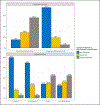Reports and Removals of Child Maltreatment-Related Hospitalizations: A Population-Based Study
- PMID: 33375836
- PMCID: PMC11326083
- DOI: 10.1177/1077559520984549
Reports and Removals of Child Maltreatment-Related Hospitalizations: A Population-Based Study
Abstract
Despite U.S. child protective services (CPS) agencies relying on mandated reporters to refer concerns of child maltreatment to them, there is little data regarding which children mandated reporters decide to report and not to report. This study addresses this gap by utilizing a population-based linked administrative dataset to identify which children who are hospitalized for maltreatment-related reasons are reported to CPS and which are removed by CPS. The dataset was comprised of all children born in Washington State between 1999 and 2013 (N = 1,271,416), all hospitalizations for children under the age of three, and all CPS records. We identified maltreatment-related hospitalizations using standardized diagnostic codes. We examined the records for children with maltreatment-related hospitalizations to identify hospitalization-related CPS reports and if the child was removed from their parents. We tested for differences in these system responses using multinomial regression. About two-thirds of children identified as experiencing a child maltreatment-related hospitalization were not reported to CPS. We found differences in responses by maltreatment subtype and the type of diagnostic code. Children whose hospitalizations were related to abuse and associated with a specific maltreatment code had increased odds of being both reported to CPS and subsequently removed by CPS.
Keywords: abuse; child maltreatment; linked administrative data; mandated reporting; neglect.
Conflict of interest statement
Declaration of Conflicting Interests
The author(s) declared no potential conflicts of interest with respect to the research, authorship, and/or publication of this article.
Figures




Similar articles
-
The Association of Race, Ethnicity, and Poverty With Child Maltreatment Reporting.Pediatrics. 2022 Aug 1;150(2):e2021053346. doi: 10.1542/peds.2021-053346. Pediatrics. 2022. PMID: 35843980 Free PMC article.
-
The Incidence of Child Maltreatment Resulting in Hospitalizations for Children Under Age 3 Years.J Pediatr. 2021 Jan;228:228-234. doi: 10.1016/j.jpeds.2020.08.040. Epub 2020 Aug 19. J Pediatr. 2021. PMID: 32822739 Free PMC article.
-
Describing maltreatment: do child protective service reports and research definitions agree?Child Abuse Negl. 2005 May;29(5):461-77. doi: 10.1016/j.chiabu.2004.06.015. Child Abuse Negl. 2005. PMID: 15970320
-
Barriers to physician identification and reporting of child abuse.Pediatr Ann. 2005 May;34(5):349-56. doi: 10.3928/0090-4481-20050501-08. Pediatr Ann. 2005. PMID: 15948346 Review.
-
A birth cohort study of Asian and Pacific Islander children reported for abuse or neglect by maternal nativity and ethnic origin.Child Abuse Negl. 2017 Oct;72:54-65. doi: 10.1016/j.chiabu.2017.07.009. Epub 2017 Jul 27. Child Abuse Negl. 2017. PMID: 28756353 Free PMC article. Review.
Cited by
-
Counts and child protection reports of diagnosed child maltreatment before and after the COVID-19 pandemic onset.Child Abuse Negl. 2023 Dec;146:106450. doi: 10.1016/j.chiabu.2023.106450. Epub 2023 Sep 13. Child Abuse Negl. 2023. PMID: 37708644 Free PMC article.
References
-
- Adolph C (2013). SIMCF: Counterfactuals and confidence intervals for estimated models. R package version 0.2.10. https://github.com/chrisadolph/tile-simcf
Publication types
MeSH terms
Grants and funding
LinkOut - more resources
Full Text Sources
Medical
Miscellaneous

